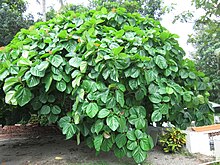Ficus auriculata
| Ficus auriculata | |
|---|---|

| |
| Scientific classification | |
| Kingdom: | Plantae |
| Clade: | Tracheophytes |
| Clade: | Angiosperms |
| Clade: | Eudicots |
| Clade: | Rosids |
| Order: | Rosales |
| Family: | Moraceae |
| Genus: | Ficus |
| Subgenus: | F. subg. Sycomorus |
| Species: | F. auriculata
|
| Binomial name | |
| Ficus auriculata Lour.
| |
Ficus auriculata (Roxburgh fig) is a type of fig tree, native to Asia,[2] noted for its big and round leaves. This is used as fodder in Nepal. It is least resistant to fire, but likes good sunlight.[3]
This plant is a small tree of 5–10 m (16–33 ft) high with numerous bristle-covered branches. The leaves are big and round, and are up to 44 cm (17 in) long and 45 cm (18 in) wide, with cordate or rounded base, acute apex, and 5–7 main veins from the leaf base. Its petioles are up to 15 cm (6 in) long, and it has stipules of about 2.5 cm (1 in) long. The plant has oblate syconium that are up to 4 cm (1.6 in) wide, covered with yellow pubescence, and emerge from the trunk or old branches of the tree.[4] Ficus auriculata is dioecious, with male and female flowers produced on separate individuals.[5]
The fresh fruit of this plant are consumed as food, and have diuretic, laxative and digestive regulating properties.[4]
Ceratosolen emarginatus is the insect that helps to pollinate this plant.[6][7]
Uses[]
In Nepal as folk remedy, Stem barks of Ficus auriculata have been used in the form of juice to treat diarrhea, dysentery, cuts and wounds.[8]
Photo gallery[]
Fruit emerging from trunk and branches
Leaf of elephant ear fig

Fruit

Leaf

Fruit

Seeds
References[]
- ^ Shao, Q.; Zhao, L.; Botanic Gardens Conservation International (BGCI).; IUCN SSC Global Tree Specialist Group (2019). "Ficus auriculata". IUCN Red List of Threatened Species. 2019: e.T147637124A147637126. doi:10.2305/IUCN.UK.2019-2.RLTS.T147637124A147637126.en. Retrieved 19 November 2021.
- ^ "29. Ficus auriculata". Flora of China.
- ^ "Ficus auriculata". ForestryNepal. Archived from the original on 2014-02-22. Retrieved 2014-02-24.
- ^ a b Tanaka, Yoshitaka; Van Ke, Nguyen (2007). Edible Wild Plants of Vietnam: The Bountiful Garden. Thailand: Orchid Press. p. 96. ISBN 978-9745240896.
- ^ Kuaraksa, Cherdsak; Elliott, Stephen; Hossaert-Mckey, Martine (2012). "The phenology of dioecious Ficus spp. Tree species and its importance for forest restoration projects". Forest Ecology and Management. 265: 82–93. doi:10.1016/j.foreco.2011.10.022.
- ^ LI Zong-Bo; YANG Pei; PENG Yan-Qiong; YANG Da-Rong (2012). "Distribution and ultramorphology of antennal sensilla in female Ceratosolen emarginatus Mayr (Hymenoptera: Agaonidae), a specific pollinator of Ficus auriculata". Acta Entomologica Sinica. 55 (11): 1272–1281.
- ^ van Noort, S.; Rasplus, J.-Y. (2018). "Ficus auriculata Loureiro, 1790". Figweb. Iziko Museums of South Africa.
- ^ Gaire, Bhakta P; Lamichhane, Ramakanta; Sunar, Chitra B; Shilpakar, Amrita; Neupane, Sabita; Panta, Sushil (2011-04-01). "Phytochemical screening and analysis of antibacterial and antioxidant activity of Ficus auriculata (Lour.) Stem Bark". Pharmacognosy Journal. 3 (21): 49–55. doi:10.5530/pj.2011.21.8. ISSN 0975-3575.
External links[]
 Data related to Ficus auriculata at Wikispecies
Data related to Ficus auriculata at Wikispecies Media related to Ficus auriculata at Wikimedia Commons
Media related to Ficus auriculata at Wikimedia Commons
- IUCN Red List least concern species
- Ficus
- Flora of the Indian subcontinent
- Flora of Indo-China
- Flora of China
- Dioecious plants
- Taxa named by João de Loureiro






